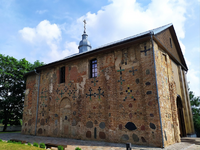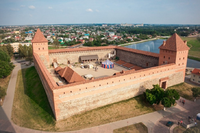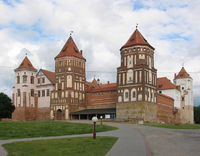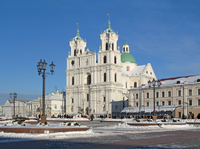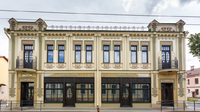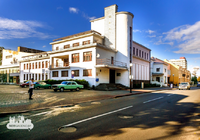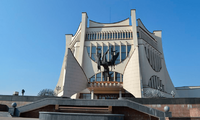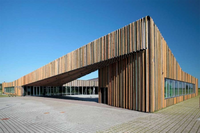Waisnorian Cultural Canon: Difference between revisions
Jump to navigation
Jump to search
No edit summary |
No edit summary |
||
| Line 44: | Line 44: | ||
|- | |- | ||
| House of Kreutzer || Vladimir Kreutzer || 1912 || House of Kreutzer, also known as "House with lilies", is the greatest example of Waisnorian modern architecture. House got such nickname thanks to intricate, but playful lily ornaments on the house. The "fame" of the house was multiplied by love affairs involving the Vladimir's daughter, drugs and several big scandals. Surviving to this day, "House with lilies" is often a meeting place of loving pairs and close friends.|| [[File:Dom-s-liliyami.png|200px|]] | | House of Kreutzer || Vladimir Kreutzer || 1912 || House of Kreutzer, also known as "House with lilies", is the greatest example of Waisnorian modern architecture. House got such nickname thanks to intricate, but playful lily ornaments on the house. The "fame" of the house was multiplied by love affairs involving the Vladimir's daughter, drugs and several big scandals. Surviving to this day, "House with lilies" is often a meeting place of loving pairs and close friends.|| [[File:Dom-s-liliyami.png|200px|]] | ||
|- | |||
| House of the Gunner || Vladislav Zhuravlev || 1924 - 1926 || House of the Gunner in Smorgon is the first constructivist building in Waisnor, built to be used by a para-military association called "Shooting Union" during Second Carrelie Period. This building serves as the symbol of 1920's and the Second Carrelie Period in Waisnorian architecture. During Soviet times, it was transformed into a training facility, most notable for being a place where world-known gymnast Olga Korbut practised. Nowadays, the house is transformed into a museum of constructivism.|| [[File:Dom-ofitserov.png|200px|]] | |||
|- | |||
| Building of the Grodno Dramatic Theatre || Gennady Machulsky || 1984 || Building of the Grodno Dramatic Theatre is regarded as the outstanding example of Soviet modernism and one of the most beautiful modernist buildings in the whole of Western Europe, with light and round outlines and some parts of neofuturism and expressionism present in the building. The building is still in frequent usage, housing the theatre and many important cultural events, often landing in the centre of cultural zeitgeist.|| [[File:Grodno Theatre.png|200px|]] | |||
|- | |||
| Millenium Centre || Dmitry Malinovsky || 2000 || Millenium Centre is the all-purpose center located in Molodechno, opened in 2000 to house different events - press conferences, debates, even contests and stand-up nights. The main idea of the building was to bridge 20th and 21st centuries with architecture, using brick walls and materials of 20th century and forms and outlines of 21st century. Millenium Centre is the most recognisable building of Molodechno, being at center of the city life quite frequently, while being a striking example of post-Soviet Waisnorian architecture and it's capability of being of the cutting edge of worldwide trends. || [[File:Molodechno.png|200px|]] | |||
|- | |||
| Library of the Braslav University || Denis Moroz || 2011 || Library of the Braslav University is one of the most recognisable examples of Waisnorian modern architecture with clean lines and unusual forms being immediately memorable. Immediately, the building of the library was recognized abroad, becoming a driving force for students to enroll into the university. Moreover, the international success of the library became a drive for other architects to try new ideas, signifying the full introduction of modern architecture into Waisnor. || [[File:Braslav uni.png|200px|]] | |||
|} | |} | ||
Revision as of 11:55, 18 August 2023
Waisnorian Cultural Canon was established in 2023 in Waisnor to "highlight the greatest works of art done in Waisnor and by Waisnorians". With the the committee assigned with the creation of the canon created in June of 2023, full list was revealed in August of 2023, consisting of 70 entries, divided into 7 categories 10 entries each: folklore, architecture, theatre, music, cinema, visual arts, and literature. It was also stated that the canon was open to further induction in the future. Waisnorian Cultural Canon also served as showcase of Waisnorian culture to the world with possibilities of future tours and translations of included works, especially in the WMCA aliance.
Folklore
| Name | Significance |
|---|---|
| Traditional Waisnorian dances, including šerahovka | Waisnorian traditional dances are one of the main and earliest parts of Waisnorian identity, developing on their own around 9th - 10th century and after that passing through generations to reach modern day. Dances accompanied many important moments of person's life, like a birth, wedding or funeral. The most well-known of them is šerahovka - a dance involving people lining up in two or more lines and dances involving interaction of said lines between together. In 2013, Waisnorian traditions of dances were included in UNESCO Intangible Cultural Heritage List. |
| Traditions and customs of Waisnorian wood-cutting | Wood-cutting was an integral part of Waisnorian culture for centuries and the one that is greatly cultivated in the present day through several centres of education. Wood-cutting is Waisnor greatly features geometrical and elaborate natural patterns, sometimes depicting scenes of wildlife and village life. Another distinctive feature is the usage of tree bark, either as framing or to highlight some parts of the cutting. Wood-cutting is present in modern-day Waisnor through not only souvenirs, but also home appliances like cupboards, doors and jewelry boxes. This tradition was also included in UNESCO Intangible Cultural Heritage List in 2017. |
| Marian celebration of the icon of Our Lady of Budlsau | The history of Marian celebrations begins in the beginning of 17th century, when several miraculous healings from such illnesses as blindness and epilepsy were attributed to the icon. Since then, there were recordings of many pilgrimages to Budslav, where the icon resided in Church of the Assumption of the Blessed Virgin Mary. Traditions of yearly pilgrimages survived through Russian Empire and Second Carrelian period, before being phased out during Soviet times. But during independence years, cult of the icon resurfaced with yearly pilgrimages resuming. In 2018, these celebrations were also included in UNESCO Intangible Cultural Heritage List. |
| Special art of flower wreaths weaving | For centuries, flower wreath weaving was one of the arts every young woman knew and cherished, with some continuing to do so in modern times. This art was prominent due to symbolism of resulting wreaths - every flower in it had a unique meaning, and combinations of flowers could telegraph some important messages (there were recordings of people communicating with each other with these wreaths). Nowadays this art is once again cultivated in rural area, and there are several shops in Waisnor specialising on making wreaths for special occasions. |
| Christmas King of the Hill celebrations | One of the main features of Waisnorian celebrations of Christmas is the massive King of the Hill play. In past centuries, there were times when all the boys and girls in the village were playing this game before returning to their homes for a Christmas feast. The tradition started to die down in 20th century, but in 2000's it managed to recover of once again become the integral part of Christmas celebrations. But there were some features added - the game could be played in building made from snow, like castles, or mix up with other activities like snowball fights. |
| Stork pattern of Miory | Stork pattern, which originated in the town of Miory somewhere in 14th century, involves sophisticated geometrical patterns and always depicts a stork, either flying or standing on his leg. Since then, the pattern was depicted on dresses, towels, curtains and more, with some variations in term of patterns but keeping in theme with two rules of Miory pattern. Over time this pattern became a symbol of pride among citizens of Miory and Waisnor as a whole, given that it was depicting the national animal of Waisnor. |
| Traditional fortune-telling carols of Waisnor | These carols were answers for Waisnorians wanting to look into future for centuries. Usually performed at the beginning of the year, these carols usually involved calling the higher forces to give them guidance and to tell them what awaits them in the future. These are many variations of these carols depending on the subjects - about love, harvests, birth of a child, death, and life in general. The carols still live in modern Waisnor through intense documentation of them in folklore works, and also sometimes used in popular music (for example in of the endings of "5th Department). |
| Brewing of traditional beer drinks | Waisnor has a robust beer culture, taking roots from Kievan Rus times when there were several beer-like drinks in Waisnor. Some of them did include hop or malt in the recipe, but brewers relied on local herbs, and so, drinks varied in alcohol concentration, with being considered safe even for children, while others were known as really strong. Brewing traditions were reintroduced to Waisnor in independence era, when such drinks became Waisnorian alternatives to Western craft beer. |
| Traditional Waisnorian folk dresses | Waisnorian dresses are one of the intergal parts of national folklore, often showing up in modern depictions of Waisnorian rural life. One of the main features of Waisnorian folk dress are the ribbons of different colours which are woven into the dress. Beads were also present in the dress, often accompanying the main part. There were also intricate and colourful parts woven on mostly white surface of the dress. Waisnorian folk dress is still used in modern times, often as a part of folklore celebrations, but some people can make their traditional dresses into wedding ones simply by adding a veil. |
| Vakanki | Vakanki are Waisnorian celebrations of relatives and friends and honorings of those who passed away, usually held in the summer. For centuries, Vakanki were a break for Waisnorians from summer work and allowed them to have some rest. Moreover, it was an opportunity for Waisnorians to meet with their family members who were far away for them rest of the year. Vakanki are one of the oldest cultural traditions of Waisnor, with first recordings about them made in Polish-Lithuanian Commonwealth period. After surviving Russian Empire, both Carrelie periods and Soviet Union, Vakanki are still frequently held in modern Waisnor, now also being held in cities. |
